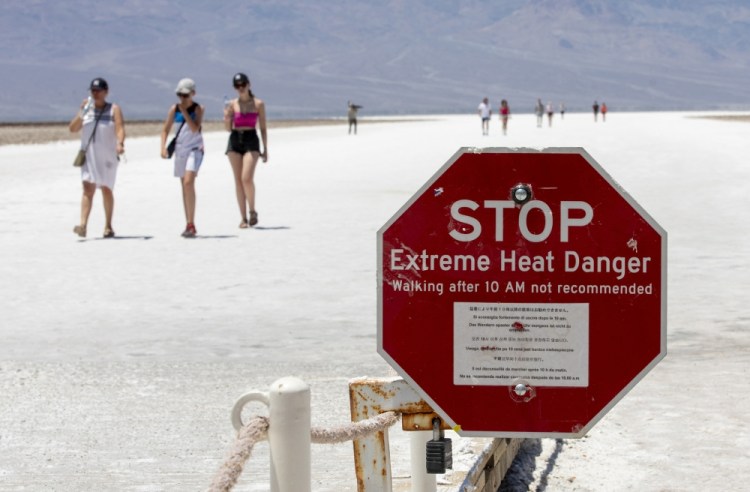

On July 8, stop signs were erected in Badwater Basin in Death Valley National Park, California, to warn tourists about the extreme heat. Daniel Jacobi II/Las Vegas Review-Journal via The Associated Press
On July 22nd, the Earth reached a frightening milestone: global temperatures reached their highest point on record, breaking the record set just one day earlier. This year is expected to be the hottest in centuries, with heat waves that are hotter, longer, and more frequent than those in the 1960s.
By now, most of us understand that extreme heat can have adverse health effects, putting extra strain on organs like the heart, lungs, and kidneys, but we all too often overlook the quieter, less visible effects that heat can have on another vital organ: the brain.
Extreme heat not only makes us irritable and uncomfortable, it also makes it harder to think clearly and be productive at work. It also worsens our mental health, exacerbating common mood disorders like anxiety and depression, as well as less common conditions like schizophrenia and self-harm. As temperatures rise every year, this issue demands more time and attention.
Normally, a part of the brain called the hypothalamus keeps your body temperature at a natural temperature, which for most people is around 98.6 degrees Fahrenheit. But your brain can only devote so much energy to it, explains Kim Maidenbauer, a social, cognitive, and environmental neuroscientist at Washington State University. On a hot day, “the first thing that seems to decline is higher-level cognitive function,” she says. That makes it harder to pay attention, and impairs working memory (the human ability to process and keep track of information in real time).
For some, the cost is high: older people, young children, people taking certain medications for schizophrenia or depression, and those with certain medical conditions or disabilities have trouble regulating their body temperature.
One analysis of private health insurance claims from the past decade found that hotter days were associated with increased emergency department visits related to a variety of mental illnesses. Emergency department visit rates were higher in the northern U.S., suggesting that cities in these regions need to better adapt their infrastructure to help people when temperatures soar, says Amruta Nori-Sarma, an assistant professor in the Department of Environmental Health at the Boston University School of Public Health, who led the study. Understanding what’s driving these visits and who is most at risk is crucial for preparation and prevention.
Heatwaves have also been linked to an increased risk of suicide: In a climate resilience review published this month, London officials said the risk of suicide in the UK was twice as high when temperatures were 32°C compared to 22°C (90°F and 72°F).
People with schizophrenia are also at disproportionate risk of dying from the effects of extreme heat: About 8% of people who died in British Columbia’s heatwaves in 2021 were people with schizophrenia, despite making up less than 1% of the province’s population.
Liv Yoon, a sociologist at the University of British Columbia in Vancouver, is trying to understand the complex causes of these deaths. Yoon says multiple factors are at play, including both physiological deficiencies and social vulnerabilities. One symptom of schizophrenia is not knowing the state of one’s own body, making it hard to tell how hot or cold one is. In addition, people with schizophrenia often take medications that can reduce the body’s ability to regulate its own temperature.
What are the solutions? Mitigating the mental health impacts of climate change will require obvious structural fixes, such as policies aimed at limiting global warming, addressing the social determinants of health, or improving urban design to minimise dangerous hotspots.
Hospitals need to know when to expect an influx of patients, while also doing more to reduce demand by addressing mental health needs before they reach a crisis point and helping people access resources during heatwaves. This is especially true for people with schizophrenia, who are less likely to use public resources like cooling centers.
Many small changes can be made right now, like training mental health workers to be more aware of the dangers of heat so they can check in on the most vulnerable, connect patients to more resources, and make sure they know that their medications are at increased risk when temperatures rise.
We can all make a difference. “More and more studies are finding that social isolation is a big factor in predicting danger in extreme heat,” Yoon says. The City of Vancouver has promoted “Cool Kits,” physical bags filled with items to help people stay safe in the heat. But public health officials are increasingly recognizing that social connections are just as important, Yoon says.
Nori Sarma says reliance on community is one of the best predictors of resilience: “Those social connections are often the strongest defense we have.”
These small actions — checking in on a friend, keeping up with family text messages, or keeping an eye on a neighbour who lives alone — can have a huge impact on the most vulnerable in society.
It’s worth remembering this as the scorching summer months drag on.
_____
©2024 Bloomberg LP Visit bloomberg.com/opinion Distributed by Tribune Content Agency, LLC.
Copy story link
” previous
Today’s Cartoon
Next ”
Related article



